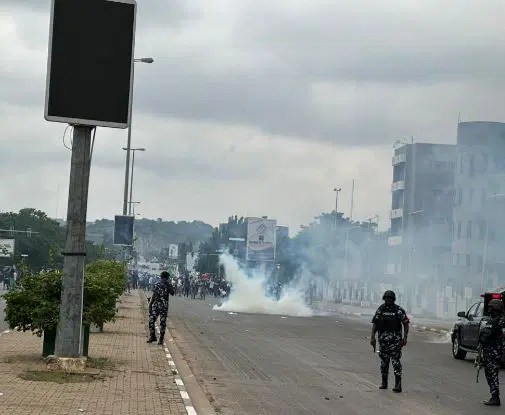As Nigerians embark on widespread protests against economic hardship a serious issue demands our attention: the danger and pollution resulting from the extensive use of teargas by the police.
In our bid to solve one problem, we must avoid creating new ones!
Beginning August 1, 2024, young people across Nigeria took to the streets to speak truth to power, driven by the high cost of living that has left many struggling to access basic needs like food.
But in an attempt to control the protests and maintain order, the police resorted to deploying large amounts of teargas. This approach is sparking new health concerns and causing environmental harm.
On Thursday, reports emerged of multiple teargas releases in the Federal Capital Territory Abuja against peaceful protesters. Borno, Kaduna, Kano. Some other locations where protests had been hijacked by miscreants, resulting in property damage, also had teargas released.
“As we were protesting yesterday, when we got to Eagles Square, so we were like trying to organise ourselves, the next thing, the police did not even talk to us, they did not even address us, they just started to shoot teargas.
“Instead of shooting teargas up in the sky, they faced it directly against us, as if they are fighting a war. They finished all the teargas and another set of MoPol came from behind to continue,” lamented a protester, Ademola, whose face was badly injured after being hit by a teargas canister.
The extensive use of teargas has raised alarm among environmental and health experts, highlighting an issue that warrants serious attention.
Journalist Mary Adeboye, reporting for News Central Television, was also injured while covering the protests in Abuja. “We were trying to move from where they were shooting the teargas. I wasn’t facing the police, and I wanted to move to the other side. While moving, I saw the policeman who shot the tear gas, and it hit my leg. In fact, it is still painful and I can’t use it to walk right now,” she said.
Beyond Physical Injuries: Teargas and Environmental Damage
Teargas comprises agents used to subdue individuals in a non-lethal manner. The three most commonly used agents are o-chlorobenzylidenemalononitrile (CS), chloroacetophenone (CN), and oleoresin capsicum (OC). These chemicals can cause significant environmental harm. When released, they disperse through the air, soil, and water.
In urban centers like Lagos, Abuja, and Kano, teargas particles can linger, impacting residents long after the protests have ended. These particles can cause immediate irritation to the eyes, throat, and skin, and can lead to breathing difficulties for those who inhale them.
Read Also: Just In: Police teargas protesters at Eagle Square
While the effects of teargas typically subsides 15-30 minutes after a person exits the exposure area and cleans up, long-term exposure can result in serious health issues, including respiratory problems and skin damage.
Tragically, videos from the protest sites show police officers walking through the fumes without sufficient protective gear, exposing themselves to potential harm.
Sadly, nearby homes will be affected, with children, the elderly, and those with preexisting health conditions being particularly vulnerable.
A Call for Better Solutions
Experts have recently urged the police to explore safer methods of crowd control. “The impact of teargas on our environment and health is serious. We need to find non-toxic methods that don’t harm people,” a medical doctor stated in a recent video.
Here are a few other alternatives that can be used by our Police to ensure the protests remain peaceful:
1. Non-lethal tools such as foam batons, sound cannons, or dye markers can help manage crowds without causing lasting harm.
2. Public address systems can be used to communicate with protesters, reducing misunderstandings and maintaining order.
3. Physical barriers can also be employed to manage the flow of protesters and prevent them from entering restricted areas without resorting to force.
These alternatives are more sustainable than the use of teargas.
As we have found ourselves in these challenging times, it is crucial that we consider the broader effects of environmental pollution by teargas. Solutions that protect both people and the environment must be prioritized.
Addressing one issue should not exacerbate another. If we focus on using teargas to disperse protesters, we risk long-term health and environmental consequences.
It is imperative that both the Nigerian police and protesters understand the broader implications of the current format. Sustainable, health-conscious approaches must be prioritized to ensure the safety of all.
We call on Nigerian leaders to demonstrate strength and wisdom during these times, as their actions are vital in safeguarding the well-being of our people and preserving our environment.
The post FEATURE… Hardship Protests: How extensive use of teargas impacts health, environment appeared first on Latest Nigeria News | Top Stories from TVN.
Join Television Nigerian Whatsapp Now
Join Television Nigerian Facebook Now
Join Television Nigerian Twitter Now
Join Television Nigerian YouTUbe Now

























